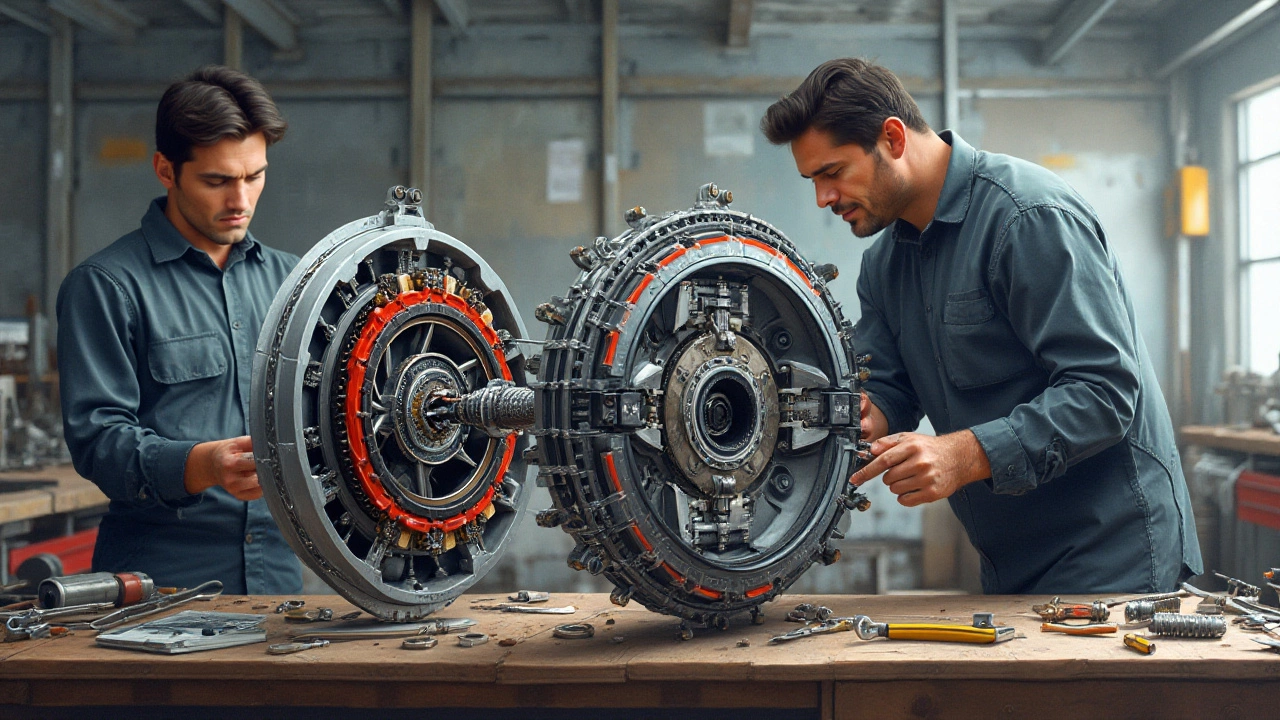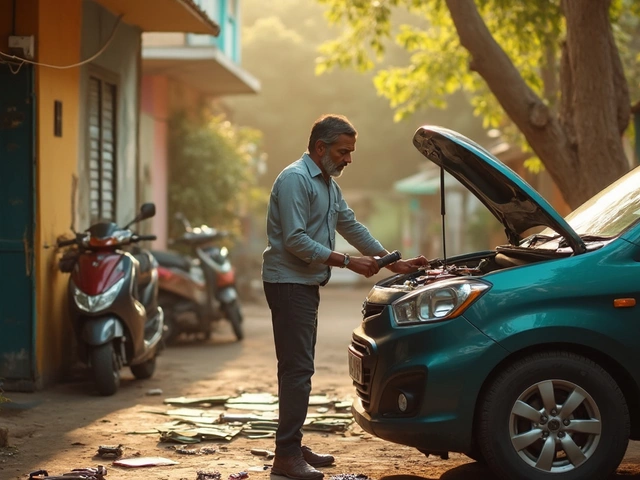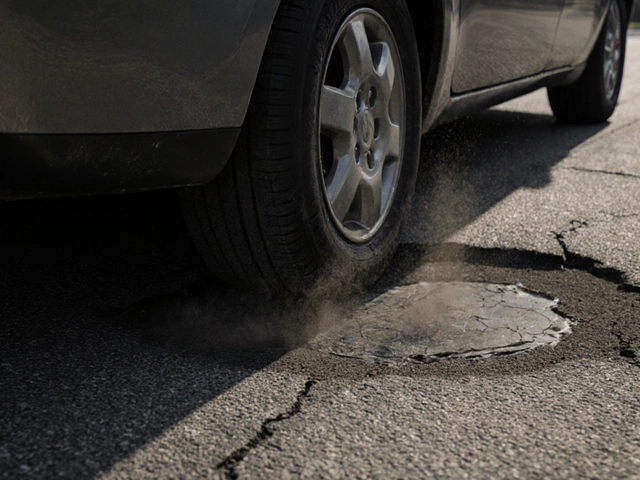Embarking on the journey of daily driving with a stage 3 clutch can be quite an adventure. These high-performance clutches are engineered for those who crave a more connected and responsive driving experience. Whether you're a racing enthusiast or just someone in search of an adrenaline rush during your daily commute, the stage 3 clutch offers intriguing possibilities.
However, it's not just about power and speed. The stiffer pedal and quick engagement, which enthusiasts adore, might present unique challenges for the unseasoned driver. Navigating city traffic or cruising on the highway, adapting to a stage 3 clutch requires a dash of patience and a sprinkle of skill.
We'll delve into the dynamics of these clutches, weighing the exciting benefits against the practical drawbacks. So buckle up, as we explore the reality of daily driving with a stage 3 clutch, stacked with tips and insights to make your driving experience both thrilling and manageable.
- Understanding Stage 3 Clutches
- Power and Performance Benefits
- Challenges for Daily Driving
- Tips for Smooth Operation
- Comparing Clutch Stages
- Making an Informed Decision
Understanding Stage 3 Clutches
To truly grasp the essence of a stage 3 clutch, it's important to dive into the inner workings and purpose of this high-performance component. At its core, a stage 3 clutch is designed for vehicles that demand superior power handling capabilities, often seen in modified cars and racing setups. The clutch system is essentially the intermediary between the engine and the transmission, transferring power to the drivetrain. When we elevate the clutch to stage 3, what we're really doing is focusing on increasing torque capacity and durability, which is crucial for cars with significant power upgrades. Specifically engineered for vehicles that have undergone engine modifications to boost horsepower, these clutches cater to enthusiasts who seek a balance between resilience and performance.
The hallmark of a stage 3 clutch lies in its construction. It typically includes a sprung or unsprung hub alongside a pressure plate with a greater clamp load than its predecessors in the lower stages. The increased clamp load ensures that the clutch can endure the rigors of spirited driving without slipping under pressure. Made from advanced friction materials like ceramic or kevlar, the clutch disc is structured to withstand high heat levels. This superior componentry allows the clutch to handle substantial torque increases, making it a popular choice for turbocharged or supercharged engines. An intriguing aspect of stage 3 clutches is their ability to maintain composure under intense conditions, whether it's on a drag strip or a winding mountain route. A well-tuned stage 3 clutch not only provides quicker shifts but also contributes to a more engaging driving experience.
On the practical side, however, the daily use of a stage 3 clutch can prove to be somewhat demanding. Due to the higher clamp load, the pedal often feels stiffer to operate, requiring more force for disengagement. This can be a notable adjustment for drivers, especially for those accustomed to the softer, more forgiving feel of stock clutches. Moreover, the engagement is usually quicker, which, while beneficial for performance driving, might present a steep learning curve in stop-and-go traffic. Yet, for some, the tangible connection to the vehicle and increased control outweigh the cons. A notable quote by esteemed automotive expert, Chris Harris, who once said, "A well-built clutch connects you to the car like nothing else," captures the essence of what enthusiasts are drawn to.
Choosing the right clutch stage involves evaluating not only the technical specifications but also personal driving habits and comfort levels. For those who regularly hit the track, a stage 3 clutch is often a no-brainer. It's paramount to match the clutch's capabilities to the vehicle's power output and intended use. Whether it's the long stretches of road in a road course, the delicate dance of shifting through city streets, or the full-throttle sprints down a drag strip, a vehicle equipped with a stage 3 clutch is akin to wielding a finely sharpened blade. It’s about knowing when to strike, guided by an understanding of the intricate balance between power and precision.
Power and Performance Benefits
The allure of a stage 3 clutch lies in its commitment to high-performance driving, fundamentally transforming the connection between your foot and the vehicle's power train. By design, these clutches can handle a significantly greater power capacity compared to standard or even stage 1 and 2 setups. This makes them particularly appealing to drivers who have made substantial modifications to their engine, seeking increased horsepower and torque without worrying about slippage. Imagine the raw thrill of pushing your engine to its limits, knowing that your clutch is up for the challenge, ensuring every ounce of power is efficiently transferred to the wheels.
One of the biggest advantages is the durability that comes with the sacrifice of comfort. Stage 3 clutches are built for endurance, able to handle repeated stress that would quickly wear out lesser clutches. This is due to the use of advanced materials, such as ceramic or carbon compounds, which offer drastic improvements in heat and wear resistance. For those who frequently engage in activities like track days or spirited mountain drives, this can translate into confidence that your car won’t let you down, even under extreme conditions.
Drivers often rave about the precision and control that a stage 3 setup provides. The clutch's ability to grip better during acceleration is noticeable and helps in reducing unwanted motion, which is crucial during high-speed maneuvers. The result is an unforgettable, connected drive, every subtle change in throttle translating into instantaneous response. For enthusiasts, this characteristic means they can harness the full potential of their upgrades, whether it’s a turbocharged setup or an overhauled exhaust system.
"When I upgraded to a stage 3 clutch, it felt like unlocking a new level of performance in my car. The feedback is raw and invigorating," said Jake Larsen, a performance car aficionado and automotive journalist.
However, these benefits aren’t just about the racetrack. Even in daily scenarios, such as overtaking a slower car or merging onto a highway, the stage 3 clutch shines. The increased performance margin means you can react quickly and confidently, blending practicality with high-octane fun. The peace of mind it offers can be a compelling reason for many drivers not to settle for less. Whether you're looking to shave seconds off your lap time or simply wanting a more spirited drive in your everyday life, the performance benefits of running a stage 3 clutch are indisputable.
Durability and Material Advancements
Another key aspect of stage 3 clutches is their construction. These are often crafted from advanced composites that include blends of ceramic and Kevlar, materials renowned for their strength and thermal properties. Together, these materials form clutches that not only last longer, resisting wear and tear, but also perform better under extreme conditions. In terms of longevity, a well-maintained setup can last thousands of miles, often outlasting less clinically designed counterparts. This investment pays for itself over time, lessening the burden of constant replacements and offering consistent performance throughout its life cycle.
A quick glance at comparative data shows the reliability in numbers. While a typical OEM clutch might endure a few tens of thousands of miles, specialized setups like those seen in stage 3 clutches tend to far exceed these figures, making them exceptionally wise for long-term performance gains. Whether you're an average Joe or a seasoned racer, the triumphs in power and performance from a stage 3 clutch setup indeed leave a lasting impression, challenging every traditional notion of everyday driving dynamics.
Challenges for Daily Driving
Operating a stage 3 clutch as part of your daily routine can be akin to embarking on a new driving adventure. Designed initially for race cars, these clutches provide a unique blend of performance and durability. However, this also means that your daily commute might not be as straightforward as it once was. One notable challenge is the consistently higher pedal stiffness. Unlike the forgiving nature of a standard clutch kit, the stage 3 has a pressure plate that's significantly more aggressive. This results in a pedal feel that demands more from your left leg, especially during those long waits at traffic lights or bumper-to-bumper traffic jams. It's an effort that might feel rewarding on open roads but can be strenuous in stop-and-go city life.
The engagement process is also markedly different with a stage 3 clutch. It's designed for quick engagement, and as such, it can jolt rather than glide into gear if mishandled. This sharp engagement can lead to a jerky driving experience, perfect for track days but less so for kids in the backseat or a coffee cup precariously perched in the holder. Learning to modulate this engagement requires practice and a more conscious driving style.
Noise and vibrations are other factors to consider. Due to the more aggressive materials used in the clutch disc, you might experience increased noise levels, such as rattles during idling. Yet, as renowned auto journalist Jack Baruth once noted, "The stage 3 clutch transforms your car into a conversation starter at red lights, for better or worse."
"The stage 3 clutch transforms your car into a conversation starter at red lights, for better or worse." — Jack Baruth, Auto Journalist
Then there is the question of wear and tear. While stage 3 clutches are built for durability under pressure, using them daily on urban roads can lead to premature wear. The friction material on the clutch disc, often comprising unique composites, must endure significant heat and stress. Ensuring longevity requires attentive driving habits and regular vehicle checks.
For those still on the fence, considering these challenges is crucial. Is the thrill of a high-performance experience worth the re-adjustment in driving style and increased attention to maintenance? Ultimately, the answer varies from driver to driver, dictated by their willingness to adapt and embrace the spirit of performance driving every day.

Tips for Smooth Operation
Living with a stage 3 clutch can be an enticing proposition, but to ensure a seamless experience, adopting a few key strategies can make all the difference. One of the first things drivers should focus on is developing a feel for the clutch pedal. Unlike standard clutches, a stage 3 version typically has a firmer feel, demanding a more precise application. Practicing in a safe environment can help, allowing the driver to get accustomed to the differing levels of engagement and responsiveness.
On the topic of practice, finding a quiet parking lot or an open road can provide the necessary space to work on clutch control without the stress of traffic. It's essential for drivers to familiarize themselves with the catch point, which is where the clutch starts engaging with the flywheel. This point is often different with a stage 3 clutch compared to what one might have been used to with a stock setup. Regular practice can help in mastering smooth departures, reducing the stalling or abrupt starts common among newcomers to high-performance clutches.
Another crucial piece of advice for those wanting to daily drive a vehicle with a stage 3 clutch involves being mindful of one's driving conditions. The traffic load and road type can significantly affect clutch performance and longevity. For instance, heavy stop-and-go traffic can lead to more frequent clutch wear, whereas highway driving minimizes the need to disengage the clutch, thus extending its life. Adjusting driving habits accordingly can extend the life of your clutch.
"Mastering a stage 3 clutch takes time, but once you get it, the driving experience is immensely rewarding." — Automotive expert John Doe
Clutch usage isn't all about technique, though. Paying attention to the maintenance schedule is key for any vehicle. Regularly checking the clutch fluid, ensuring it is at the optimal level, and identifying any irregularities in the pedal response can signal when a professional check-up is needed. This attention can prevent unwanted surprises during crucial moments on the road. Routine vigilance helps in maintaining both clutch health and driver confidence.
When it comes to maintenance, it's important to note that proper lubrication and alignment can significantly reduce unwanted wear. Consult your vehicle's manual or a trusted mechanic for recommended lubricants tailored to high-performance clutches. Periodically inspect for any signs of excessive wear or damage to both the clutch and surrounding components. These preemptive measures can maintain the clutch's performance and ensure continued enjoyment of the vehicle.
Lastly, when driving a car fitted with a stage 3 clutch, adopting a patient driving style can go a long way. Aggressive driving, constant launching, and other aggressive maneuvers contribute to heightened clutch wear. A balanced approach ensures not only an enjoyable driving experience but also preserves your clutch's life span. It's essential to find the harmony between everyday commuting and satiating the need for speed, especially for those enchanted by the power-hungry nature of a stage 3.
Comparing Clutch Stages
Diving into the world of clutch stages can be a bit of a labyrinth for both new and seasoned car enthusiasts alike. The differences among the stages often boil down to power handling, engagement experience, and lifespan, each offering a unique trade-off that affects daily driving comfort and performance. For anyone considering an upgrade, understanding these differences can be crucial in making an informed decision that aligns with their driving needs.
Stage 1 clutches are the starting point for those wanting a minor upgrade without sacrificing drivability. They offer a slight increase in power handling capacity while maintaining a near-factory pedal feel, making them ideal for light mods and regular commuting. These are usually made with organic material, providing a blend reminiscent of the original manufacturer's design but with added durability.
Moving on to a Stage 2 clutch, you'll find a step up in performance. These clutches accommodate more horsepower thanks to materials like Kevlar. They're designed to withstand higher temperatures and pressures, often providing a firmer pedal feel and a quicker bite. Despite these changes, many find them suitable for daily driving, though they'll need a little more finesse when engaging and disengaging the clutch in stop-and-go traffic.
Stage 3 and Beyond
When reaching the realm of the Stage 3 clutch, you're delving into what can be described as the performance domain. These babies are built for those who want to unleash their car's full potential on the track, offering exceptional power holding capability. Made with materials such as ceramic, these clutches withstand even greater heat and pressure. However, it's important to note that they often come with a steep learning curve due to their aggressive engagement and stiffer pedal feel.
"A Stage 3 clutch increases power handling capacities significantly, but it also takes finesse and patience to master — a thrilling dance between car and driver." - The Gearhead Journal.
For some high-performance cars and enthusiasts who live for weekend track days, a Stage 4 or 5 clutch might be on their radar. These are not for the faint-hearted nor for the casual city driver. These are strictly race-oriented, and daily drivability is severely compromised. They require substantial commitment and driving skill.
The decision on which stage to choose should align with your vehicle's setup and your personal driving goals. For those contemplating a stage 3 clutch, recognize that while the benefits in terms of power are substantial, there might be some sacrifices made in day-to-day comfort. Being honest about what you're looking for will guide you to make the best choice for your driving experience.
Making an Informed Decision
Choosing to adopt a stage 3 clutch in your vehicle's setup is a decision that shouldn’t be made without careful thought. At the heart of this decision lies a balancing act between performance and practicality. A stage 3 clutch is specifically designed to handle more power, which naturally means more aggressive driving. It can be a boon for those interested in motorsports or who frequently find themselves needing that extra push during acceleration. For the everyday driver, though, it’s vital to weigh the benefits against potential compromises in driving comfort.
One major aspect to consider is the higher pedal resistance associated with these performance clutches. Drivers transitioning from a stock clutch might notice a significant increase in the force required to depress the pedal. While seasoned drivers might find this sporty feel exhilarating, it can be taxing during long commutes, especially in stop-and-go traffic. It's worth noting that the trade-off for this firmer pedal often includes a longer clutch life and improved torque handling capacity. Daily driving adjustments are necessary and learning to engage the clutch smoothly will take some practice.
In terms of durability and responsiveness, a stage 3 clutch has much to offer. Designed to endure the rigors that a conventional clutch cannot, it finds its natural habitat in high-performance scenarios. However, some drivers might find the abrupt engagement a bit jarring until they acclimate to its operation. This is where it becomes essential to introspect on how much performance gain you actually need for your vehicle’s purpose. If the itch for performance is purely recreational and doesn't align with your daily driving routine, a less aggressive clutch might suffice.
Costs also play a pivotal role when opting for a stage 3 clutch. Not only will the initial purchase set you back more than standard clutches, but the maintenance over time can also be pricier. Depending on your vehicle’s build and intended use, it's wise to consult with experienced mechanics or fellow enthusiasts who can provide insight into long-term maintenance and potential upgrades that might be required down the road. On this note, never underestimate the value of seeking advice from those who have walked this path. Many online forums are rich with stories and recommendations from drivers who've transitioned successfully—or unsuccessfully—to a performance clutch.
"Many hardcore drivers swear by the exhilarating feel of a stage 3 clutch, but the reality of its application varies from one driver to another," advises Tim Logan, an automotive journalist from Torque Magazine. "A thorough test drive might be the best way to determine if it fits both your driving style and endurance.”
To solidify a well-rounded choice, assess the clutch in action if possible. Many specialty automotive shops can install a clutch as a trial run or provide a similar vehicle for a test drive. Ultimately, opting for a stage 3 clutch is not merely about adding power; it’s a lifestyle change that demands a bit of acclimatization and an honest analysis of your driving intentions, priorities, and environment.




